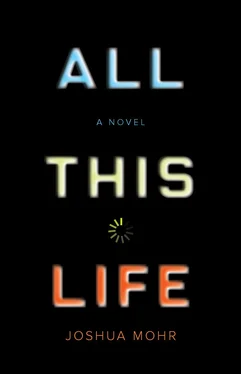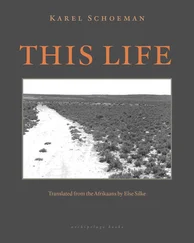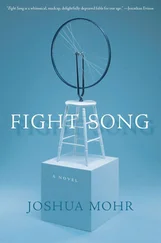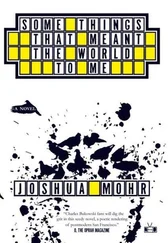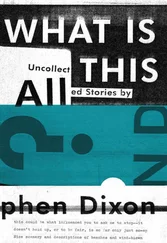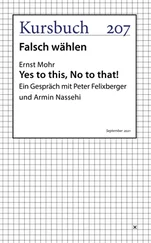“How about a picture?” Deb says. “Can you draw us all?”
“Let me finish setting up and I’ll get on it,” says Kat.
Deb points her binoculars at the Golden Gate Bridge. Balloon Boy senses that something catches her eye and asks, “What?”
She hands him the binoculars. Rodney puts them to his eyes and Deb guides him in the right direction with a pointer finger.
“Do you see that guy?” Deb says. There’s a man working on a scaffold way up near one of the bridge’s towers and Rodney nods. “He’s painting the bridge,” Deb says. “They have to do it all year, every year. The saltwater and fog strip off the paint pretty fast, and they’re always touching it up. They call those spots scars.”
“Let me see,” says Sara, and Rodney hands her the binoculars. “Do they really call them scars?”
“Cross my heart,” Deb says.
“The bridge is so pretty from here,” Sara says. “You’d never know what happened yesterday.”
Kathleen watches the three of them hand the binoculars back and forth, taking turns peering up as the man erases the scars with new paint. Sara’s right: The bridge is beautiful from here. It is the site of her near-murder not even twenty-four hours ago, yet watching the sun hit its orange beams, the bridge shimmers, postcard perfect. Kathleen can’t see any traffic from this angle, only the huge towers, the tangle of wires like a nest, the arch across the ocean. The sky is clear and the sun hits the ocean and bounces the brightness back up, making it almost too much light to bear.
Too bad that they can’t point those binoculars and see into the future. Too bad they can’t see Noah three weeks from now, sitting in a tapas restaurant in the Mission, at one of the new chic spots that Kathleen detests. He’s on a first date, his inaugural social outing since Tracey died.
He had forgotten about his match.com profile until he got this notification email: “Swagga_gurl has winked at you!” He clicked on her page, read all about her, sent a note right back. Here was a woman who knew nothing about him, nothing about his sister, and that sounded fantastic.
They will go out a few more times, but nothing comes of it. It fizzles; they fizzle. Both will tell people that nothing was wrong with the other, there simply wasn’t a connection. That word! Connection. To be connected. To be bridged across any divides. To be plugged into a network. To be alive.
It doesn’t matter that they didn’t connect. It only matters that Noah took the time to meet her, that he’s trying, that the rate of vodka bottles being emptied in his apartment is slowing. There are no directions for putting the pieces together, like his dad assembling that chair in the new arts and crafts studio. No, Noah has to make it up as he goes along.
If the binoculars are pointed in a different direction, they can see Wes’s body being immolated. Nobody claimed him, and six weeks after his death he was shipped to a county facility. To be cooked alone.
He is loaded into a cardboard casket and slid into the retort. A steel door lowers, the brick walls smeared with the film of thousands of deaths. Black smudges like signatures.
She was here.
He was here.
A few wands jet from the retort’s ceiling, like stalactites. Fire wisps innocently at the ends of these until a worker throws the switch, and these wands are alive with fire. It engulfs the cardboard casket. The lid is the first to lose its solidity; slowly the sides slip away too. There’s a moment when he lies there naked, completely whole. A flash before the fire does what fires do, and Wes starts disappearing. His skin bubbles and pops from the scorch. Skin smoldering. Hair burns and soon skin is torn, huge holes forming and showing his ribcage, see the matter and organs baking and burning, turning to ash. Watch his heart lose its codes of love, watch his heart cave in. The worker throws the switch again to turn off the fire, and he opens the oven’s doors, collecting what remains.
Pity the binoculars can’t spy Paul and Jake. They sit in the therapist’s office, in the waiting room without any hanging meringue, the one with six chairs, a palm tree, a rickety Formica coffee table with old magazines.
Jake is dreading what will happen once he’s ushered inside. What he’ll find out. What he’ll have to talk about. What he’ll have to hear. Siri only answers questions that she’s been asked. This doctor will pose anything he wants and sit there practicing his lip-pursing until Jake participates.
Paul is scared, too. What’s going on in his psyche is a collision of extremes: He wants to know the doctor’s diagnosis, and yet that information is the last thing he can bear hearing.
Finally, the doctor’s door opens, and he wanders a few steps into the waiting room and asks Jake if he’s ready.
The boy stands up but doesn’t move toward the office, repulsed by the fact that the doc is already pursing his lips and he hasn’t even asked any of his questions yet. Jake begins an entirely different walk on an entirely different moon.
“Go ahead,” Paul says, ushering his boy with a supportive shove in the lower back.
Jake takes three steps and stops. He doesn’t want to have his hard drive opened, doesn’t want anybody running diagnostics and a debugger, doesn’t want his head combed for malware. “Would you like to come in and talk?” the doctor asks.
Jake hasn’t moved, looks back at his dad. Perhaps that first astronaut peered over his shoulder to the probe, to the others on his team, before striking out into the magnificent desolation. He’s scared and maybe that’s okay. Jake takes the next three steps, then crosses the threshold into the office before the doctor shuts the door.
There Paul sits. In the waiting room. In the dark. Trusting this man to help his child. He stares at the closed door, settling in, waiting for the hour to elapse, waiting an impossible amount of time to hear impossible news, hoping, tenderly hoping, that today turns out to be the best day of their lives.
“YOU ALL READYto be drawn?” Kathleen asks.
Deb, Sara, and Rodney huddle together, posing for their picture. They make silly faces. Sara, for some unknown reason, hums “Purple Haze.”
“Remember that you have to draw yourself in this picture, too,” Deb says. “We all have to be in it.”
“Gotcha.”
“We all have to be in it,” Deb says.
Kat’s sponsor knew she’d try to weasel out of putting herself in, and Kathleen is thankful for that. She wants to be accountable, and Deb is the perfect hard-ass to help her do that.
“Yes, fine,” says Kathleen, “we’re all going to be in it.”
She starts this caricature, this family portrait of sorts, all the survivors. She puts the Golden Gate Bridge in the background, but doesn’t paint it solid orange. No, she likes the idea of it showing its scars, and she leaves it mottled, gray patches all over it. She draws her boy first, her boy who has shown up at this surreal time, and she captures his face’s likeness flawlessly, the only exaggerated detail is the cast on his leg, which is made of clouds in the picture, something to coddle his injury. Then she gets cracking on Sara, who once said that she was plenty scathed but in ways the naked eye couldn’t see, so Kat evokes that by making Sara’s skin solid gold; there might be something severe swimming under the surface, but Kathleen wants to show Sara that no one cares. She has value. She’s priceless. And it’s easy to draw Deb because Kat wants to show her the same skyscraping respect that she heaps on the cancer survivors in her shop: Kathleen doesn’t draw Deb’s fat lip or swollen cheek or black eye, no, she draws lush vines snaking around her face, looking like a garden nymph.
Читать дальше
